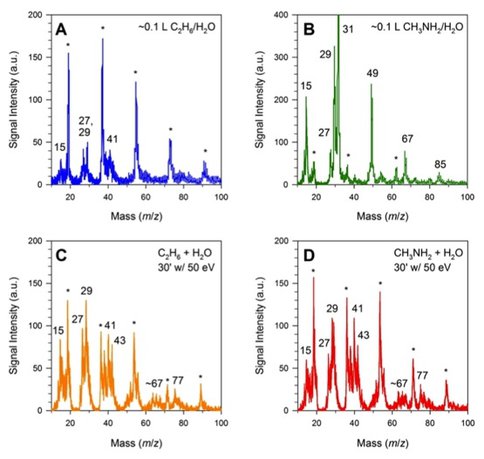2010 Annual Science Report
 NASA Jet Propulsion Laboratory - Titan
Reporting | SEP 2009 – AUG 2010
NASA Jet Propulsion Laboratory - Titan
Reporting | SEP 2009 – AUG 2010
Task 3.1.1 Reactions of Organics With Ices and Mineral Grains
Project Summary
Chemistry catalyzed by mineral grains on the Titan surface, for example a result of meteoritic infall, might lead to the formation of prebiotic compounds resulting from the insertion of oxygen into organic compounds of atmospheric origin.
Project Progress
Co-Investigator Thomas Orlando in collaboration with Postdoctoral Fellow Heather Abbott and others explored heterogeneous chemistry relevant to Titan’s surface, especially relevant to the lake regions where fluvial features provide a liquid medium for reactions and a transportation mechanism for catalytic mineral deposits left behind by meteorite impacts such as the one that cause the Sinlap crater. Low energy electrons (5-50 eV) were used as an analog of the incident cosmic rays that may penetrate the dense atmosphere and the secondary electrons that these cosmic rays may generate near the surface. Amorphous alkanes (e.g., C2H6) and simple tholin analogs (e.g., CH3NH2) have been deposited on amorphous solid water to model the interface of the hydrocarbon “soil” and the alkane seas with the underlying water-ice “bedrock”. Experimental observations of water-ice clusters indicate that protonation occurs readily even at the low temperatures (i.e., 93-94 K) observed on Titan’s surface. Moreover, polar tholin analogs appear to be rapidly solvated by water molecules on the surface, leading to the formation of protonated methylamine-water clusters as measured by electron stimulated desorption – time-of-flight mass spectrometry (ESD-TOF). Irradiation with low energy electrons results in the formation of short-chain carbon polymers (e.g., C3Hx+). These experiments are shown in Figure 1 and are some of the first aimed at understanding chemistry at the organic-mineral interface under conditions relevant to Titan, in particular at the edges of hydrocarbon lakes.
Poster Presentations:
Heather Abbott, Jason McLain, Michele Dawley, Gregory Grieves and Thomas Orlando. “Cosmic Ray Induced Formation of Oxygen Containing Prebiotic Molecules within Ice-Mineral Interfaces,” Southeast Laboratories Astrophysics Consortium Meeting, Athens, GA (3/2010).
Heather Abbott, Jason McLain, Michele Dawley, Gregory Grieves and Thomas Orlando. “Cosmic Ray Induced Formation of Oxygen Containing Prebiotic Molecules within Ice-Mineral Interfaces,” Astrobiology Science Conference, League City, TX (4/2010).
Heather Abbott, Jason McLain, Michele Dawley, Gregory Grieves and Thomas Orlando. “Photon and electron induced reaction dynamics at the vacuum-surface and buried interface of ice covered graphitic and silicate grains,” American Chemical Society Fall Meeting, Boston, MA (08/2010).
Heather Abbott, Michele Dawley, Jason McLain, Gregory Grieves and Thomas Orlando. “Chemistry at the Organic-Mineral Interface Relevant to Titan,” Division of Planetary Science Annual Meeting, Pasadena, CA (10/2010).
Submitted Publications:
V.S. Nguyen, H.L. Abbott,* M.M. Dawley, T.M. Orlando, J. Leszczynski, and M.T. Nguyen. “A Theoretical Study of Formamide Decomposition Pathways” J. Phys. Chem. A submitted (2010).
Figure 1. ESD-TOF spectra of ethane-water and methylamine-water ices before (A&B) and after (C&D) irradiation with low energy electrons are shown. Peaks labeled * are H(H2O)n+ clusters (n=1-5 yields signal at m/z = 19, 37, 55, 73 and 91). The most intense peaks in B (i.e., m/z = 31, 49, 67, 85) correspond to CH3NH2n+ clusters. Other major peaks most likely correspond to CxHy+ species (e.g., m/z = 27-29 are C2Hx+ species, m/z = 39-43 are C3Hx+ species, and m/z = 65-69 are C4Hx+ species).
-
PROJECT INVESTIGATORS:
-
PROJECT MEMBERS:
Heather Abbott
Postdoc
-
RELATED OBJECTIVES:
Objective 1.1
Formation and evolution of habitable planets.
Objective 2.2
Outer Solar System exploration
Objective 3.1
Sources of prebiotic materials and catalysts
Objective 3.2
Origins and evolution of functional biomolecules
Objective 3.3
Origins of energy transduction
